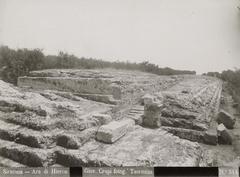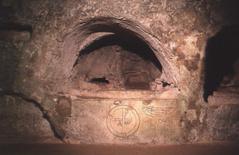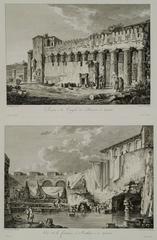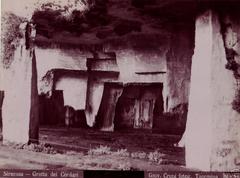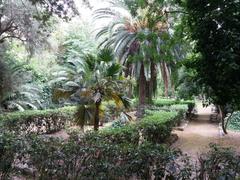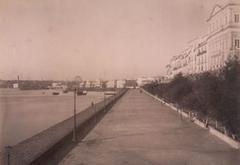Temple of Artemis Syracuse: Visiting Hours, Tickets, and Historical Significance
Date: 14/06/2025
Introduction
Nestled in the heart of Ortigia—the ancient island district of Syracuse, Sicily—the Temple of Artemis (Artemision) stands as a testament to the city’s rich Greek heritage and enduring spiritual legacy. Dating back to the 6th century BCE, the temple was an epicenter of religious devotion, mythological storytelling, and architectural innovation. Visitors today can explore its fascinating ruins, interpretive displays, and surrounding historic sites, immersing themselves in a narrative that spans Greek, Roman, and later Christian influences. Whether you are a history enthusiast, a cultural traveler, or simply curious about ancient Mediterranean civilizations, this guide provides a detailed overview of the Temple of Artemis’s history, architectural features, visiting hours, ticketing, accessibility, and practical travel tips.
For the latest updates and visitor information, consult the official Hermes Sicily blog, Lonely Planet, and Enjoy Sicilia.
Table of Contents
- Historical Overview
- Architectural Features
- Cultural and Religious Significance
- Visiting the Temple of Artemis
- Relationship to Surrounding Monuments
- Frequently Asked Questions (FAQ)
- Conclusion and Recommendations
- Sources and Further Information
1. Historical Overview
Origins and Foundation
The Temple of Artemis, or Artemision, is one of Syracuse’s most ancient religious monuments, dating to the 6th century BCE. Founded by Greek settlers, its establishment marked Syracuse’s emergence as a prominent Mediterranean polis. Artemis—goddess of the hunt, wilderness, and protector of women—was central to the city’s identity, and the temple’s dedication reflected her revered status among the city’s early inhabitants (Hermes Sicily).
Strategically located at the highest point of Ortigia, near the Temple of Athena (now Syracuse Cathedral), the Artemision symbolized both religious and civic authority.
Archaeological Discovery and Excavations
Long hidden beneath Piazza Minerva and the Palazzo Vermexio, the temple’s remains were first uncovered by Paolo Orsi in the early 20th century. Excavations revealed foundational structures, column bases, and artifacts, some predating Greek occupation, attesting to the site’s continuous significance (Lonely Planet).
Historical Significance
The Artemision exemplifies eastern Greek Ionian architectural influence, rare in Sicily’s predominantly Doric context. Over centuries, the site adapted to changing rulers and religious practices, including Roman conversion to the cult of Diana and later Christian use as a crypt—demonstrating the temple’s continuous role in Syracuse’s evolving spiritual landscape.
2. Architectural Features
Layout and Structure
The Artemision’s rectangular plan and elegant Ionic columns, with their slender forms and volute capitals, drew inspiration from monumental temples in Ionia and Samos. Original measurements were approximately 22 by 55 meters, with six columns on the short sides and 17 on the long sides (Enjoy Sicilia).
Construction Materials and Techniques
The temple was constructed of local limestone, featuring robust foundations, finely carved capitals, and terracotta roof tiles. These elements highlight both the artistry and engineering prowess of Greek craftsmen.
Later Additions and Modifications
Medieval adaptations, such as the crypt (Putridarium) used by the Brotherhood of San Sebastianello, and overlying structures like the 17th-century Palazzo Vermexio, testify to the site’s enduring sacredness and evolving function (Lonely Planet).
3. Cultural and Religious Significance
The Role of Artemis in Ancient Syracuse
Artemis occupied a vital position in Syracusan religion, revered as protector of women, springs, and childbirth. The myth of Arethusa—transformed into a freshwater spring by Artemis—became foundational for the city, influencing rituals, coinage, and urban identity (Greek Reporter).
Rituals, Festivals, and Syncretism
While specific local rites are sparsely documented, Artemis’s worship in Syracuse likely involved processions, athletic contests, music, and offerings, echoing pan-Hellenic traditions. Over time, her cult merged with Roman and later Christian practices, with the site continually repurposed for spiritual use (Greek Mythology Worldwide; Italian Insider).
Symbolism in Art and Daily Life
Artemis was depicted as a youthful huntress on Syracusan coins and artworks. The spring of Arethusa and related imagery reinforced the city’s mythological heritage, while later Christian iconography echoed Artemis’s protective gestures (Acetes Travel).
4. Visiting the Temple of Artemis
Location and Accessibility
The Artemision is centrally located under Piazza Minerva in Ortigia, adjacent to the Syracuse Cathedral. The site’s main entrance is on Via Minerva, a short walk from Piazza Duomo. Ortigia’s pedestrian-friendly layout makes the temple accessible on foot from anywhere on the island (Comune di Siracusa).
Coordinates: 37.0606° N, 15.2932° E
Getting There:
- On Foot: Best explored within Ortigia.
- By Car: Parking available on the edge of Ortigia (e.g., Parcheggio Talete), followed by a short walk.
- Public Transport: Local buses connect Ortigia with the mainland; the nearest stop is Piazza Archimede.
- By Bicycle: Rentals are available and popular for exploring the island.
Visiting Hours
- Standard Schedule: Tuesday to Sunday, 10:00 AM – 6:00 PM (closed Mondays).
- Note: Hours may vary by season or for special events; always check the Comune di Siracusa tourism portal or Sicilia Turismo for updates.
Tickets and Admission
- Standard Admission: €2–€4.
- Discounts: Available for students, seniors, groups; children under 12 and Syracuse residents often enter free.
- Where to Buy: On-site or in advance online.
Some areas of the site are viewable free from the surrounding square, but access to the archaeological area and multimedia installations may require a ticket (Sicilia Turismo).
Visitor Services and Tips
- Accessibility: Ramps, handrails, and accessible restrooms are provided; some uneven surfaces remain in the archaeological zone.
- Guided Tours: Available in multiple languages; book on-site or in advance. Audio guides are offered for a self-paced experience.
- Facilities: Information desks, rest areas, and a gift shop are located near the entrance.
- Photography: Non-flash photography is permitted; tripods require prior authorization.
- Best Times to Visit: Early morning or late afternoon for optimal lighting and fewer crowds.
For a richer visit, download the Audiala app for audio guides and digital resources.
5. Relationship to Surrounding Monuments
The Artemision is surrounded by a tapestry of historic sites:
- Syracuse Cathedral (Duomo): Built atop the Temple of Athena, just meters away.
- Temple of Apollo: Another ancient Greek temple on Ortigia.
- Fonte Aretusa: The mythic freshwater spring tied to Artemis and Arethusa.
- Piazza Archimede: Home to the Fountain of Diana, celebrating Artemis’s myth (The Crazy Tourist).
This proximity enables visitors to experience Syracuse’s layered history and mythological landscape in a single walking tour.
6. Frequently Asked Questions (FAQ)
Q: What are the Temple of Artemis visiting hours?
A: Typically Tuesday to Sunday, 10:00 AM to 6:00 PM; closed Mondays. Confirm seasonal variations online.
Q: How much are the tickets?
A: €2–€4 standard, with discounts for students, seniors, families, and free entry for children and local residents.
Q: Is the site wheelchair accessible?
A: Yes, most areas are accessible via ramps and handrails; some uneven terrain in archaeological zones.
Q: Are guided tours available?
A: Yes, in multiple languages; audio guides can also be rented on-site.
Q: Can I take photos?
A: Non-flash photography is permitted; professional equipment requires authorization.
Q: Is the site open-air or indoors?
A: The main ruins are outdoors and viewable from the square; ticketed multimedia displays are accessible inside.
Q: Is there an entrance fee to view the ruins from the square?
A: No, viewing from the square is free; admission is required for museum areas and close-up access.
7. Conclusion and Recommendations
The Temple of Artemis in Syracuse offers a compelling journey into the heart of ancient Greek Sicily. Its ruins, multimedia installations, and interpretive displays provide a window into religious, architectural, and mythological traditions that have shaped the city for millennia. With accessible facilities, affordable tickets, and a central location amidst Ortigia’s other treasures, the Artemision is an essential stop for any visitor to Syracuse.
Visitor Tips:
- Combine your visit with nearby sites such as the Syracuse Cathedral, Temple of Apollo, and Fonte Aretusa.
- Use the Audiala app for guided tours and digital enhancements.
- Check official sites for up-to-date hours and ticketing.
- Respect preservation rules and enjoy the vibrant surroundings of Ortigia.
8. Sources and Further Information
- Hermes Sicily: Temple of Artemis in Syracuse – Visitor’s Guide
- Academia.edu: Artemis in Sicily and South Italy
- Greek Reporter: Ancient Greek Metropolis Syracuse
- Enjoy Sicilia: Artemision di Siracusa
- Lonely Planet: Artemision
- Comune di Siracusa
- Sicilia Turismo
- Visit Sicily
- Italia.it: Ortigia
- Learning Escapes: What to See in Syracuse
- The Crazy Tourist: Best Things in Syracuse
- Audiala
- Acetes Travel: Religious Beliefs in Ephesus
- Italian Insider: Putridarium
- Greek Mythology Worldwide: Cult of Artemis
